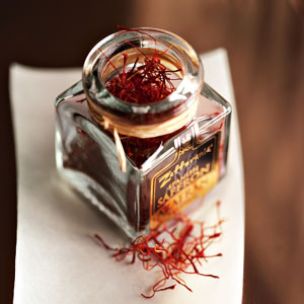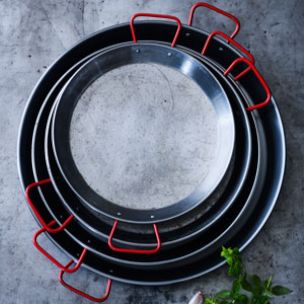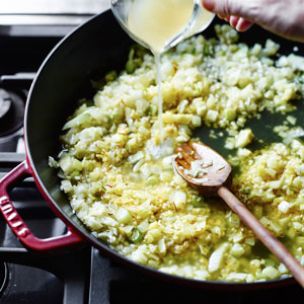Making Perfect Paella
Whether your paella includes chicken, chorizo, seafood or seasonal vegetables, the fundamentals of making this Spanish rice dish are the same. These tips will help you prepare perfect paella every time.

Use the Best Ingredients
Calasparra and Valencia rice, medium-short-grain varieties, and short Bomba rice are considered the best for making paella because they absorb liquid well and also stay relatively firm. Connoisseurs of Spanish rice refer to its perla, the pearl of starch at each grain’s core that soaks up the flavors of the other ingredients. But equally important are the seasonings that you choose. Known as azafrán in Spain, saffron is a signature seasoning in Spanish dishes, and paella in particular. Saffron threads, the dried stigmas of a flower, are still gathered by hand, so the spice is relatively expensive, but a small amount of it will contribute its characteristic yellow-orange color and unique flavor. Many paella recipes also call for pimentón, a spice made from smoked dried red peppers and available in sweet (dulce), bittersweet (agridulce) and spicy (picante) forms. Recipes will sometimes say to use paprika in its place, but use pimentón for authentic flavor.

Use a Proper Paella Pan
A paella pan, which is typically made out of carbon steel or, less commonly, enameled cast iron, is wide, round and shallow, because you want to maximize the amount of rice that touches the bottom of the pan. Sporting handles on either side, a paella pan can measure from 10 inches (25 cm) to more than 3 feet (1 m) across. Spain’s famous rice dish is traditionally cooked outdoors over a fast-burning wood fire, but today’s cooks often prepare paella indoors, on the stovetop.

Use the Right Technique
In most paella recipes, you’ll begin by sautéing onions and garlic in olive oil. At that point you will want to stir frequently to keep the ingredients from scorching. However, at a certain point in the recipe, you’ll be instructed not to stir the rice. Heed the warning! Stirring interferes with the formation of the soccarat, the irresistible crispy rice that forms on the bottom of the pan and is the hallmark of a well-made paella. Keep in mind also that, depending on the size of your pan and the configuration of your stovetop, you may need to set the pan over two burners and rotate the pan to evenly distribute the heat.
Adapted from Williams-Sonoma Rustic Spanish, by Paul Richardson (Weldon Owen, 2016)